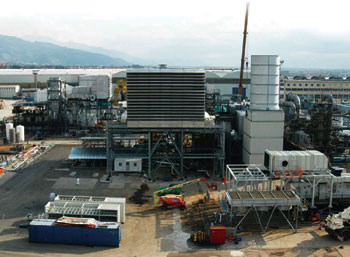 Technology from Europe: Technology from Europe:
Italy
Compression for the world’s largest nitrogen compression train
With the Qatargas I LNG project already in operation, the focus has shifted to Qatargas II. This is a joint venture between Qatar Petroleum and ExxonMobil. With a capacity of 7.8 million tons per year of LNG per train, Qatargas II’s two LNG trains will be the largest in the world. Being built in Qatar, these are the first LNG trains of this size to use GE’s compression train technology. In March 2006, tests were successfully completed on the nitrogen compression train for Qatargas II.
 |
Qatargas II will have the world’s largest gas turbine-driven compression train, with a capacity of 8 million tons/yr.
|
|
The nitrogen compression train reached 92 MW of output during the full-pressure, full-load string test – the highest power ever achieved by a single LNG compression train. The train was successfully operated for four hours at full speed and full pressure. This achievement was reached on the first attempt without the need for any modifications or corrections. The nitrogen compression train is composed of a 125-MW, single-shaft GE Frame 9E gas turbine for mechanical drive application, a 45-MW starter/ generator, a variable-speed drive system and two large centrifugal compressors: a horizontally split casing MCL1402 and a BCL1003 barrel compressor.
The MCL1402 represents one of the most advanced applications of a compressor with a horizontally-split casing, whereas the BCL1003 compressor is a large-barrel version. Both compressors are equipped with 3D impellers that can handle more than 100,000 m3/hr and are one-piece milled from a solid-forged billet.
The train’s operational control system software was developed using a special dynamic simulator that reduced the commissioning period and enabled a smooth start of the string test-fired runs.
The manufacturing and testing of the machines was simulated using numerical techniques to anticipate any problems during assembly and testing. The performances were fine-tuned and optimized by means of multistage, computational fluid dynamics to anticipate any lack of performances with respect to the contractual values. 
|

 Technology from Europe:
Technology from Europe:

